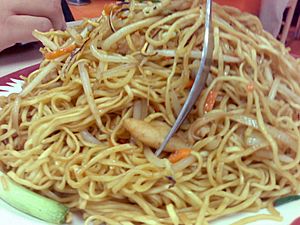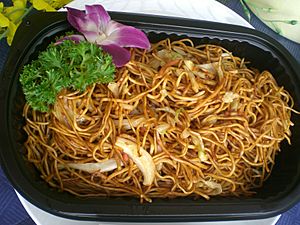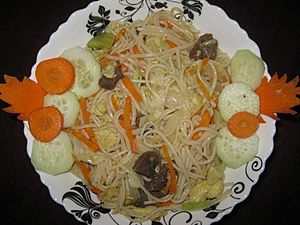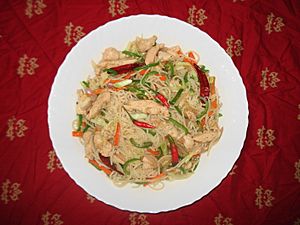Chow mein facts for kids

A plate of chow mein
|
|
| Course | Main course |
|---|---|
| Place of origin | China |
| Region or state | Guangdong |
| Serving temperature | Hot |
| Main ingredients | Noodles, soy sauce, vegetables |
| Variations | Chicken, pork, beef, shrimp, tofu |
| Chow mein | |||||||||||||||||||||
|---|---|---|---|---|---|---|---|---|---|---|---|---|---|---|---|---|---|---|---|---|---|
| Traditional Chinese | 炒麵 | ||||||||||||||||||||
| Simplified Chinese | 炒面 | ||||||||||||||||||||
| Literal meaning | "Stir-fried noodles" | ||||||||||||||||||||
|
|||||||||||||||||||||
Chow mein ( and simplified Chinese: 炒面; traditional Chinese: 炒麵; Pinyin: chǎomiàn) are Chinese stir-fried noodles with vegetables and sometimes meat or tofu; the name is a romanization of the Taishanese chāu-mèn. The dish is popular throughout the Chinese diaspora and appears on the menus of most Chinese restaurants abroad. It is particularly popular in India, Nepal, the UK, and the US.
Contents
Etymology
The words chow mein mean 'stir-fried noodles', also loosely translating to "fried noodle" in English, chow meaning 'stir-fried' (or "sautéed") and mein meaning 'noodles'. The pronunciation chow mein is an English corruption of the Toishanese pronunciation chāu-mèn. The Toishan dialect was spoken by migrants to North America from Toishan.
Regional cuisine
American Chinese cuisine
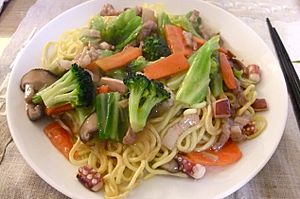
In American Chinese cuisine, it is a stir-fried dish consisting of noodles, meat (chicken being most common but pork, beef, shrimp or tofu sometimes being substituted), onions and celery. It is often served as a specific dish at westernized Chinese restaurants. Vegetarian or vegan chow mein is also common.
There are two main kinds of chow mein available on the market:
- Steamed chow mein, and
- Crispy chow mein, also known as Hong Kong-style chow mein (see below).
The steamed chow mein has a softer texture, while the latter is crisper and drier. Crispy chow mein uses fried, flat noodles, while soft chow mein uses long, rounded noodles.
Crispy chow mein either has onions and celery in the finished dish or is served "strained", without any vegetables. Steamed chow mein can have many different kinds of vegetables in the finished dish, most commonly including onions and celery but sometimes carrots, cabbage and mung bean sprouts as well. Crispy chow mein is usually topped with a thick brown sauce, while steamed chow mein is mixed with soy sauce before being served.
There is a regional difference in the US between the East and West Coast use of the term "chow mein". On the East Coast, "chow mein" is always the crispy or "Hong Kong style". At some restaurants located in those areas, the crispy chow mein noodles are sometimes deep fried and could be crispy "like the ones in cans" or "fried as crisp as hash browns". At a few East Coast locations, "chow mein" is also served over rice. There, the steamed style using soft noodles is a separate dish called "lo mein". On the West Coast, "chow mein" is always the steamed style; the crispy style is simply called "Hong Kong style" and the term "lo mein" is not widely used.
The crispy version of chow mein can also be served in a hamburger-style bun as a chow mein sandwich.
There are also variations on how either one of the two main types of chow mein can be prepared as a dish. When ordering "chow mein" in some restaurants in Chicago, a diner might receive "chop suey poured over crunchy fried noodles". In Philadelphia, Americanized chow mein tends to be similar to chop suey but has crispy fried noodles on the side and includes much celery and bean sprouts and is sometimes accompanied with fried rice. Jeremy Iggers of the Star Tribune describes "Minnesota-style chow mein" as "a green slurry of celery and ground pork topped with ribbons of gray processed chicken". Bay Area journalist William Wong made a similar comment about what is sold as chow mein in places like Minnesota. A published recipe for Minnesota-style chow mein includes generous portions of celery and bean sprouts. Another Minnesotan variant includes ground beef and cream of mushroom soup.
Food historians and cultural anthropologists have noted that chow mein and other dishes served in Chinese American restaurants located away from areas without any significant Asian American population tend to be very different from what is served in China and are heavily modified to fit the taste preference of the local dominant population. As an example, the chow mein gravy favored in the Fall River area more closely resembles that used in local New England cooking than that used in traditional Chinese cooking. The founder of the food manufacturer Chun King and the creator of canned chow mein admits to using Italian spices to make his product more acceptable to Americans whose ancestors came from Europe.
Chow mein is mentioned as early as 1920, in the novel Main Street by Sinclair Lewis.
It is frequently confused with chop suey; a dish incorrectly labeled as chow mein was sometimes served in American restaurants, drug store soda fountains, school cafeterias, senior citizens facilities, and military bases chow halls. In many of these cases, this particular dish was served over rice and did not include noodles.
In 1946, one of the first companies to market "chow mein" in a can was Chun King. The product's creator was Jeno Paulucci, the son of Italian immigrants, who developed a recipe based mostly upon Italian spices that would be better catered to the food preferences of European immigrants and some Americans of similar ethnic origins. To keep cost down, Paulucci replaced expensive water chestnuts with lower-cost celery stalks that were originally destined for cattle feed. Paulucci's company became so successful selling canned chow mein and chop suey that President Gerald Ford quipped, "What could be more American than a business built on a good Italian recipe for chop suey?" when praising Paulucci accomplishments with Chun King. After Paulucci sold Chun King in 1966, the company would be sold several more times more until it was dissolved in 1995.
By 1960, Paulucci described in The New York Times that "At Chun King we have turned out a 'stew-type' chow mein. I'd guess this type has been around for thirty - maybe forty - years. To make it, all the meat, seasonings and vegetables are dumped into a kettle and stewed for hours - until everything is cooked." At the time of the interview, "sales from restaurants 'to take home' are almost three times as great as in the food markets". Paulucci wanted to increase market share by using more effective advertising.
Australian Chinese cuisine
Traditional chow mein is made with egg noodles which are boiled then strained and left to dry. They are then stir fried and finally left to sit at the bottom of the wok and pressed down, this crisps the noodles at the edges and underside. Chow mein is made with either seafood, often just prawns, chicken, beef or barbecued pork. Restaurants will serve a combination chow mein or a single type. Chicken and beef are often softened with a little bicarbonate of soda. The sauce is made from garlic, rice wine, light stock, MSG, salt and corn flour. Vegetables are usually one green such as bok choy or choy sum plus a little chopped carrot, but also other green vegetables are acceptable. This stir fry is poured onto the noodles. Chow mein is unique as its noodles are both soft in part but also crispy.
Brazilian Japanese cuisine
Chow mein was brought to Brazil by Japanese immigrants and is thus referred to as yakisoba ( or ). It fits Brazilian tastes rather than Japanese ones though, and is thus more similar to the North American versions of chow mein.
Pastelarias and Asian restaurants serve it in the entire country. They generally are presented in chicken (the most common), beef, shrimp and pork versions, with vegetarian and egg versions being much rarer. Brazilian yakisoba is typically served much more al dente than the Japanese, being also heavy in soy sauce, sesame oil, and vegetables, almost always including at least carrot, cabbage, onion and at least one dark green species (usually other than kale, collard, spinach, chicory or mustard) such as Chinese cabbage, and less often either bean sprouts, broccoli/broccolini, zucchini, shiitake, bell pepper and/or cucumber.
Also popular is yakibifum ( from Japanese yakibīfun), its equivalent that uses rice vermicelli instead of wheat noodles. Brazilian spring rolls' (rolinhos-primavera or harumakis) fillings generally use the same ingredients of the stir-fried noodles in the restaurants or fast-food chains they are found, though spring rolls may have cheese, usually white (such as catupiry or other kinds of requeijão, or queijo minas), or tofu instead of meat, uncommon for the noodles. All of them, but most often and especially spring rolls, may be served with bright red molho agridoce (sweet-sour sauce), that combines ketchup, vinegar, sugar, star anise and other spices.
Canadian Chinese cuisine
Canadian westernized Chinese restaurants may offer up to three different types of chow mein, none of which is identical to either of the two types of American chow mein. Cantonese style chow mein contains deep-fried crunchy golden egg noodles, green peppers, pea pods, bok choy, bamboo shoots, water chestnuts, shrimp, Chinese roast pork (char siu), chicken, and beef, and is served in a thick sauce. Plain chow mein is similar to other Western chow meins but contains far more mung bean sprouts; some regional recipes may substitute bean sprouts for noodles completely. In Canada, Hong Kong style chow mein is similar to plain chow mein but is always served on a bed of deep-fried crunchy golden egg noodles. The Japanese Canadian community also have their own version of chow mein that might include dried seaweed and pickle ginger and could be served in a bun.
In Newfoundland, their chow mein does not contain any noodles. In place of noodles, cabbage cut in such a way to resemble noodles are used as a substitute. Although no one knows the reason why this change had occurred, it is believed that the island remoteness in the North Atlantic during its history as an independent self-governing British dominion contributed to the lack of availability of the necessary ingredients from the rest of North America or from Europe.
Caribbean Chinese cuisine
Many West Indian people include chow mein in their cuisine, especially peoples from islands like Trinidad and Tobago and Jamaica which include a significant ethnic Chinese population; much of the cooking has infused itself into the population in general. As well, in the South American countries Guyana and Suriname the culture and cuisine is similar to the Caribbean's. These chow mein dishes are cooked in a similar manner, with green beans, carrots, peas, onions and sometimes other vegetables. Meat used is mostly chicken and sometimes pork and/or shrimp. The main difference is that local spices are added, and the dish is often served with hot Scotch bonnet peppers and/or pepper sauce.
In Cuba, aside from the foreign-owned tourist hotels which often serve Western-style Chinese food, local Chinese restaurants can be found in Havana that offer a distinct Cuban style.
In Panama, chow mein is prepared with a mixture of shredded carrots and cabbage with pork or chicken and served over noodles. Another recipe includes canned corn.
Indian Chinese cuisine
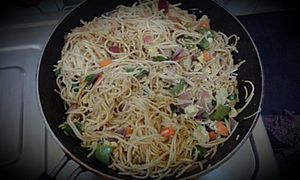
Chow mein is also common in Indian Chinese, Bangladeshi Chinese, and Pakistani Chinese cuisine. In India, it was introduced by the Chinese of Calcutta. It is usually offered Hakka or with gravy. Catering to vegetarian diets, there is an Indian variant, vegetable chow mein, which consists of noodles with cabbage, bamboo shoots, pea pods, green peppers, and carrots. In the New Delhi area, chow mein can sometimes include paneer with the mixture of noodles and vegetables. Another non-meat Indian variant includes scrambled egg as a protein source. Kolkata has its own variant that is called Calcutta Chow Mein or Calcutta Chowmin that also includes green chilli, chilli garlic, or hot garlic.
Indonesian Chinese cuisine
There are two Indonesian versions of chow mein. One is Mie goreng, which is (sometimes spicy) stir-fried noodle dish with variants of toppings, and the other is a crispy noodle dish topped with sauce that is pretty popular and existed in virtually all Chinese restaurant in Indonesia. It goes popular with the name of I fu mie or Mi Siram, literally means drenched noodle, in Indonesian Chinese cuisine. In Indonesia, i fu mie is usually served with thick egg sauce with cauliflower, broccoli, mushroom, kekkian or prawn cake, and chicken. Several varieties does exists such as vegetarian and seafood that contains squid, prawn and fish instead of kekkian. The dish is often confused with Lo mein.
Mexican Chinese cuisine
Chow mein has gained popularity in Mexico, which received waves of Chinese immigrants in the past, particularly in northwestern Mexico. Mexicali, a city in Baja California, is known for its distinct style of chow mein, which typically use Mexican ingredients as substitutes for traditional Chinese ones, an adaption that was made by Chinese immigrants settling the area.
Nepalese cuisine
Tibetans who settled in Nepal brought chow mein with them. It is a popular fast food in Nepal. The Newari people of the Kathmandu Valley use water buffalo meat and chicken in their cuisine, and chow mein in Nepal is often cooked with onion, vegetables and buff (water buffalo meat).
Peruvian Chinese cuisine
Chinese food (Chifa) is very popular in Peru and is now a part of mainstream Peruvian culture. Chow mein is known to Peruvians as Tallarín saltado and may contain peppers, onions, green onions, and tomatoes.
See also
 In Spanish: Chow mein para niños
In Spanish: Chow mein para niños


